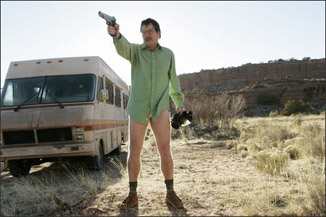|
|
Mythology: Breaking BadBy Martin FelipeApril 7, 2010
The visuals are masterful in how they reflect this dichotomy within Walt. Much like Leone's work, the scenes and the individual shots often last far longer than we are used to in standard television. The color is saturated, making the reds deeper, the greens greener. There's a filth, a dirtiness to the beautiful desert scenery. A viewer can almost feel the heat and taste the death. This languid pacing, coupled with an almost methodical presentation of events, adds to the sense of unease. Television writing is often about being just one step ahead of the viewer. Too many steps and viewers might get confused, too many steps behind and they might get bored. Breaking Bad is brilliant at taking its time and keeping viewers riveted. Events flow slowly, logically, even inevitably, but never fail to compel the viewer. Of course, great character work and acting is key, but there's also a very precise methodology to the presentation. Similar to the Coens or Leone, we often watch events unfold step-by-step, in a very dreamlike rhythm. Unlike the Coens or Leone, the dialogue and character interactions is very naturalistic, undercutting the rigorous presentation. The Coens especially use dialogue more for rhythm and meter, and Leone's characters are often men of few words. Breaking Bad, perhaps to bridge the gap between its sprawling ambitions and television expectations, cuts the edge of the precision with clever, yet natural and efficient dialogue. Perhaps owing more to the Coens than Leone or Anderson, the side characters provide some killer-entertaining quirk to compliment the darker desperation Walt embodies. Raymond Cruz's Tuco is an exaggerated wild card, Bob Odenkirk's Saul Goodman walks the fine line between sleazy lawyer spoof and hilarious caricature to brilliant effect. Dean Norris invests Hank with layers of insecurity, giving the character far more dimension than the small-time Vic Mackie he first seems to be. It's these oddball supporting players, much like in a Coen flick, who provide entertaining relief to the oppressiveness of the landscape, the pacing, the themes. Mad Men gets the awards and the headlines. It deserves them - the show's brilliant. Nevertheless, Breaking Bad is unlike any other show on television today. It's a contemporary spaghetti western. The style is cinematic, the themes are complex, the acting is extraordinary. Most importantly, the storytelling is just brilliant. It may not be fair that Mad Men enjoys the bulk of the attention, but Breaking Bad is still there, doing its thing and doing it well, just waiting for viewers to watch it.
|

|
|
|

|
Friday, November 1, 2024
© 2024 Box Office Prophets, a division of One Of Us, Inc.


